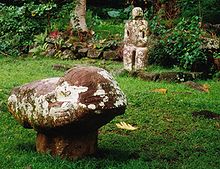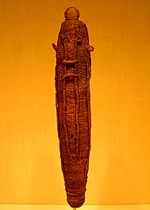- Polynesian mythology
-
Polynesian mythology is the oral traditions of the people of Polynesia, a grouping of Central and South Pacific Ocean island archipelagos in the Polynesian triangle together with the scattered cultures known as the Polynesian outliers. Polynesians speak languages that descend from a language reconstructed as Proto-Polynesian that was probably spoken in the Tonga - Samoa area around 1000 BC.
Contents
Description
Prior to the 15th century AD, Polynesian people fanned out to the east, to the Cook Islands, and from there to other groups such as Tahiti and the Marquesas. Their descendants later discovered the islands from Tahiti to Rapa Nui, and later Hawai‘i and New Zealand. Latest research puts the settlement of New Zealand at about 1300 AD. The various Polynesian languages are all part of the Austronesian language family. Many are close enough in terms of vocabulary and grammar to permit communication between some other language speakers. There are also substantial cultural similarities between the various groups, especially in terms of social organisation, childrearing, as well as horticulture, building and textile technologies; their mythologies in particular demonstrate local reworkings of commonly shared tales.
Thus, in some island groups, Tangaroa is of great importance as the god of the sea and of fishing. There is often a story of the marriage between Sky and Earth; the New Zealand version, Rangi and Papa, is a union that gives birth to the world and all things in it. There are stories of islands pulled up from the bottom of the sea by a magic fishhook, or thrown down heaven. There are stories of voyages, migrations, seductions and battles, as one might expect. Stories about a trickster, Māui, are widely known, as are those about a beautiful goddess/ancestress Hina or Sina.
In addition to these shared themes in the oral tradition, each island group has its own stories of demi-gods and culture heroes, shading gradually into the firmer outlines of remembered history. Often such stories were linked to various geographic or ecological features, which may be described as the petrified remains of the supernatural beings.
From oral to written
The various Polynesian cultures each have distinct but related oral traditions, that is, legends or myths traditionally considered to recount the history of ancient times (the time of "pō") and the adventures of gods (“atua”) and deified ancestors. The accounts are characterised by extensive use of allegory, metaphor, parable, hyperbole, and personification. Orality has an essential flexibility that writing does not allow. In an oral tradition, there is no fixed version of a given tale. The story may change within certain limits according to the setting, and the needs of the narrator and the audience. Contrary to the Western concept of history, where the knowledge of the past serves to bring a better understanding of the present, the purpose of oral literature is rather to justify and legitimatise the present situation.
An example is provided by genealogies, which exist in multiple and often contradictory versions. The purpose of genealogies in oral societies generally is not to provide a 'true' account, but rather to emphasise the seniority of the ruling chiefly line, and hence its political legitimacy and right to exploit resources of land and the like. If another the ruling line should rise to ascendency, it was necessary to bestow upon the new line the most prestigious line, even if this meant borrowing a few ancestors from the preceding dynasty. Thus each island, each tribe or each clan will have their own version or interpretation of a given narrative cycle.
This process is disrupted when writing becomes the primary means to record and remember the traditions. When missionaries, officials, anthropologists or ethnologists collected and published these accounts, they inevitably changed their nature. By fixing forever on paper what had previously been subject to almost infinite variation, they fixed as the authoritative version an account told by one narrator at a given moment. In New Zealand, the writings of one chief, Wiremu Te Rangikāheke, formed the basis of much of Governor George Grey's Polynesian Mythology, a book which to this day provides the de facto official versions of many of the best-known Māori legends.
Some Polynesians seem to have been aware of the danger and the potential of this new means of expression. Thus as of the mid-19th century, a number of them wrote down their genealogy, the history and the origin of their tribe. These writings, known under the name of "pukapuka whakapapa" (genealogy books, Māori) or in tropical Polynesia as "puta tumu" (origin stories) or "puta tūpuna” (ancestral stories) were jealously guarded by the heads of households. Many disappeared or were destroyed. Thus in the 1890s, Makea Takau, a Rarotongan chief, ordered his tribe to burn all their family books, save his own. As a result, Makea Takau's version became the official history of the chiefly line, removing the possibility of dissent. At his request, extracts were published in the Journal of the Polynesian Society.
See also
- Ghosts in Polynesian culture
- Hawaiian mythology
- Hina (goddess)
- Māori mythology
- Maui (mythology)
- 'Oro
- Rapa Nui mythology (Easter Island)
- Samoan mythology
- Sina and the Eel
References
- Beckwith, Martha, Hawaiian Mythology, Yale University Press, 1940, as re-issued in 1970, University of Hawaii Press
- Buck, Sir Peter / Te Rangi Hiroa, Samoan Material Culture. bishop Museum bulletin.
- Kirch, Patrick, 'On the Road of the Winds' 2000, University of California Press.
- Malo, David, Hawaiian Antiquities, first published in English in 1898, available as Bernice P. Bishop Museum Special Publication 2, Second Edition, 1951
List of resources about traditional arts and culture of OceaniaArt ahu · Australia · Austronesia · Cook Islands · Hawaiʻi · kapa (Hawaiʻi) · lei (Hawaii) · magimagi · Māori · moai · New Zealand · nguzu nguzu · Oceania · Papua New Guinea · reimiro · tā moko · tapa ["masi" (Fiji), "ngatu" (Tonga), "siapo" (Sāmoa), " ʻuha" (Rotuma)] · tabua · ta'ovala · tattoo · tēfui · tivaivaiBroad culture Geo-specific, general Australia · Australian Aboriginal astronomy · Austronesia · Caroline Islands, -Pwo · Chatham Islands · Cook Islands · Easter Island · Fiji, -Lau Islands, -traditions and ceremonies · Guam · Hawaiʻi, -Lomilomi massage · Kiribati · French Polynesia's Marquesas Islands · Marshall Islands, -Stick charts of · Federated States of Micronesia · Nauru · New Caledonia · New Zealand · Niue · Norfolk Island · Palau · Papua New Guinea · Pitcairn Islands · Sāmoa · Solomon Islands · Tonga · Torres Strait Islands · Tuvalu · Vanuatu · Wallis and Futuna · Yap, -navigation, -Weriyeng navigation schoolCanoes Aboriginal Dugout · Alingano Maisu · Drua · Dugout (boat) · Hawaiʻiloa · Hōkūleʻa · Modern Hawaiian outrigger · Māori migration · Outrigger · Polynesian sailing · Proa · Waka,-List of · WalapDance Festivals Australia's Garma Festival · Hawaiʻi's Aloha Festivals, Merrie Monarch Festival, and World Invitational Hula Festival · Fiji · New Zealand's Pasifika Festival · The Pacific Community's Festival of Pacific Arts · Festivals in Papua New GuineaLanguages by areaLanguages of Oceania Sovereign states - Australia
- East Timor (Timor-Leste)
- Fiji
- Indonesia
- Kiribati
- Marshall Islands
- Federated States of Micronesia
- Nauru
- New Zealand
- Palau
- Papua New Guinea
- Samoa
- Solomon Islands
- Tonga
- Tuvalu
- Vanuatu
Dependencies and
other territories- American Samoa
- Christmas Island
- Cocos (Keeling) Islands
- Cook Islands
- Easter Island
- French Polynesia
- Guam
- Hawaii
- New Caledonia
- Niue
- Norfolk Island
- Northern Mariana Islands
- Pitcairn Islands
- Tokelau
- Wallis and Futuna
by categoryLiterature Literature of Oceania Sovereign states - Australia
- East Timor (Timor-Leste)
- Fiji
- Indonesia
- Kiribati
- Marshall Islands
- Federated States of Micronesia
- Nauru
- New Zealand
- Palau
- Papua New Guinea
- Samoa
- Solomon Islands
- Tonga
- Tuvalu
- Vanuatu
Dependencies and
other territories- American Samoa
- Christmas Island
- Cocos (Keeling) Islands
- Cook Islands
- Easter Island
- French Polynesia
- Guam
- Hawaii
- New Caledonia
- Niue
- Norfolk Island
- Northern Mariana Islands
- Pitcairn Islands
- Tokelau
- Wallis and Futuna
Music Austral Islands (French Polynesia) · Australia · Austronesia · Cook Islands · Easter Island · Fiji · Guam · Hawaiʻi · Kiribati · Lali · Māori · Melanesia · Northern Mariana Islands · Micronesia · Federated States of Micronesia · Nauru · New Caledonia · New Zealand · Niue · Palau · Papua New Guinea · Polynesia · Sāmoa · Slit drum · Solomon Islands · Tahiti · Tokelau · Tonga · Tuvalu · Vanuatu · Wallis and FutunaMythology Australian Aboriginal · Fijian · Māori · Melanesian · Menehune · Micronesian · Oceanian legendary creatures · Polynesian · Rapa Nui · VanuatuPeople Indigneous Australian · Austronesian · Chamorro · Chatham Islander (Moriori or Rekohu) · Fijian · Hawaiian (kānaka maoli) · Māori · Marshallese · Melanesian · Micronesian · Negrito · Norfolk Islander · Papuan · Polynesian · Indigenous Polynesian (Mā’ohi) · Rapanui · Rotuman · Samoan · Tahitian · Tongan · Torres Strait IslanderReligion Religion in Oceania Sovereign states Dependencies and
other territories- American Samoa
- Christmas Island
- Cocos (Keeling) Islands
- Cook Islands
- Easter Island
- French Polynesia
- Guam
- Hawaii
- New Caledonia
- Niue
- Norfolk Island
- Northern Mariana Islands
- Pitcairn Islands
- Tokelau
- Wallis and Futuna
Not included: Oceanian: cinema, (indigenous) currency, dress, folkore, cuisine. Also see Category:Oceanian culture.Categories:
Wikimedia Foundation. 2010.


